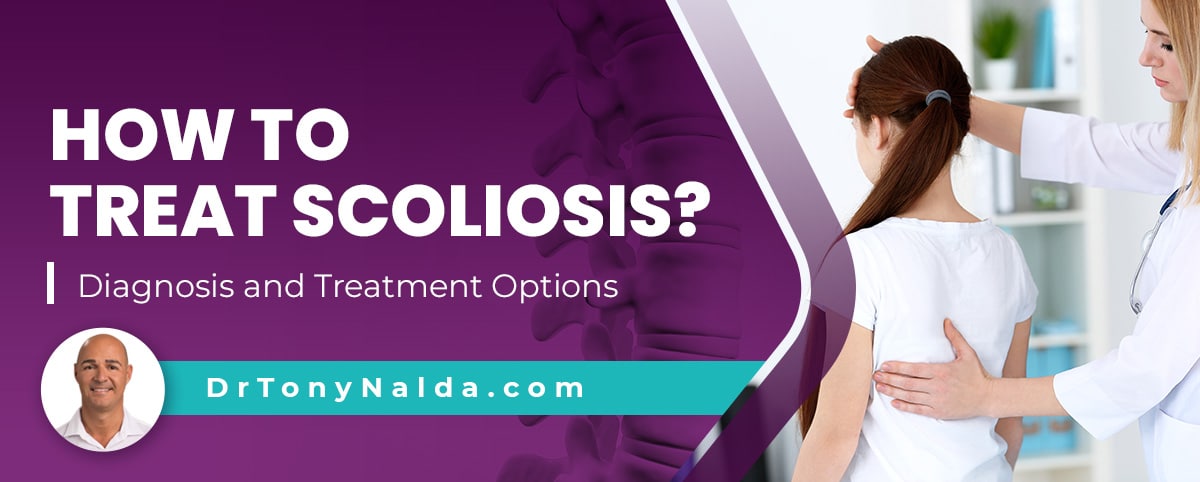How To Treat Scoliosis? Diagnosis and Treatment Options

Diagnosing scoliosis involves a physical examination and an X-ray to truly see what's happening in and around the spine, and treating scoliosis is about being proactive and working towards counteracting the condition's progressive nature.
When it comes to being diagnosed with scoliosis, the most important decision to be made is how to treat it; as a progressive condition, scoliosis is incurable, but it can be highly treatable. Conservative treatments for scoliosis patients combine chiropractic care, physical therapy, corrective bracing, and rehabilitation.
As a patient's experience with scoliosis starts with their diagnosis, let's start with how diagnoses are reached.
Table of Contents
Diagnosing Scoliosis
Scoliosis is a complex structural spinal condition that involves a loss of its healthy curves, and in order to be diagnosed as a true scoliosis, it has some criteria to meet.
Scoliosis has a rotational component, which is what makes it a 3-dimensional condition, and the size of the unnatural spinal curve has a minimum requirement: Cobb angle measurement of at least 10 degrees.
A patient's Cobb angle is an important part of classifying conditions in terms of severity and shapes the design of treatment plans.
Determined during X-ray, measuring a patient's Cobb angle involves drawing lines from the tops and bottoms of the curve's most-tilted vertebrae, and the intersecting lines form an angle that's expressed in degrees.
The more severe a condition, the higher the Cobb angle, the further out of alignment the spine is, and the more overt the condition's effects are likely to be:
- Mild scoliosis: Cobb angle measurement of between 10 and 25 degrees
- Moderate scoliosis: Cobb angle measurement of between 25 and 40 degrees
- Severe scoliosis: Cobb angle measurement of 40+ degrees
- Very-severe scoliosis: Cobb angle measurement of 80+ degrees
In addition to condition severity, part of the diagnostic process involves further classifying conditions based on patient age, curvature location, and condition type.
Classifying Scoliosis
Patient age is important for predicting a patient's progressive rate; as a progressive condition, scoliosis has it in its nature to worsen over time, and growth is the condition's progressive trigger.
Patient age also tells us whether back and nerve pain is likely to be a symptom because scoliosis becomes a compressive condition once skeletal maturity has been reached.
There are three main spinal sections: the cervical spine (neck), thoracic spine (middle/upper back), and the lumbar spine (lower back).
 Curvature location is important not only because it tells me where to concentrate my treatment efforts, but because it also helps predict the area of the body that's most likely to be directly affected.
Curvature location is important not only because it tells me where to concentrate my treatment efforts, but because it also helps predict the area of the body that's most likely to be directly affected.
Condition type is determined by causation, and in approximately 80 percent of known diagnosed scoliosis cases, they are classified as idiopathic scoliosis, and the remaining 20 percent are associated with known causes: neuromuscular scoliosis, congenital scoliosis, and degenerative scoliosis.
Neuromuscular scoliosis patients have a larger neuromuscular condition that's causing the development of their scoliosis such as cerebral palsy, spina bifida, or muscular dystrophy, and the larger neuromuscular condition has to be the focus of treatment.
In degenerative scoliosis, the cause is natural age-related spinal degeneration, so a focus of treatment is preserving spinal function and improving support and stabilization of the spine.
Congenital scoliosis cases are rare, affecting 1 in 10,000 infants born with a malformed spine, and treatment involves close monitoring and modifying treatment plans.
The most prevalent type of scoliosis diagnosed overall is adolescent idiopathic scoliosis, diagnosed between the ages of 10 and 18.
Treating Scoliosis Patients
How to treat scoliosis will depend on the type of treatment approach chosen.
There are two main scoliosis treatment approaches for patients to choose between, and each offers a different potential result, which is why patients need to be fully informed as to the risks and benefits associated with each.
The choice of one treatment approach over another can have far-reaching effects; as a progressive condition, scoliosis is incurable, but it can be highly treatable, especially with early intervention and proactive treatment.
An abnormal curvature of the spine shouldn't be ignored, particularly a progressive one.
Scoliosis progressing means the size of the scoliotic curve is increasing, as are the condition's uneven forces, and their effects.
The more scoliosis progresses, the more complex it is to treat, which is why how a diagnosis is responded to with treatment is so important.
Traditional treatment for scoliosis tends to funnel patients towards spinal fusion surgical treatment, while modern conservative treatment opts for a proactive non-surgical treatment response.
Scoliosis Surgery
Scoliosis surgery is also known as spinal fusion and involves fusing the curve's most-tilted vertebrae into one solid bone so they can't become more tilted (progress), and in most cases, metal rods are attached to the spine with pedicle screws to hold it in place; hardware attached is permanent.
Some risks associated with the procedure itself can include:
- Nerve damage
- Excessive blood loss
- Adverse reaction to hardware used
- Infection
Just as no two cases of scoliosis are the same, no two patients will respond to treatment in the exact same way, but some common long-term effects associated with spinal fusion can include:
- Increased back pain at the fusion site
- A spine that's weaker and more vulnerable to injury
- A noticeable loss in spinal flexibility and range of motion
- Hardware malfunction over time
While some patients will opt for surgical treatment, the reality is that many people with scoliosis experience nonsurgical treatment success.
Conservative Non-Surgical Treatment
Conservative treatment involves a non-surgical response that values being proactive by starting treatment as close to the time of diagnosis as possible.
Here at the Scoliosis Reduction Center, I address scoliosis with conservative chiropractic-centered treatment that works towards preventing progression, increasing condition effects, and the need for invasive surgical procedures in the future.
 I want to impact scoliosis on every level, but as a structural spinal condition, it has to first and foremost be impacted on a structural level, and this can be worked towards through chiropractic care that involves a series of techniques and manual adjustments that reposition the curve's most-tilted vertebrae back into alignment with the rest of the spine.
I want to impact scoliosis on every level, but as a structural spinal condition, it has to first and foremost be impacted on a structural level, and this can be worked towards through chiropractic care that involves a series of techniques and manual adjustments that reposition the curve's most-tilted vertebrae back into alignment with the rest of the spine.
Once I start to see an unnatural curvature of the spine reduce, I can shift the focus to increasing core strength so the spine's surrounding muscles can support it optimally, and through physical therapy and scoliosis-specific exercises, most patients can also address bad posture, any related muscle imbalance, and improve brain-body communication by activating specific areas of the brain.
Corrective bracing can be particularly effective on growing spines, so is a regular facet of adolescent idiopathic scoliosis treatment, and rehabilitation involves scoliosis-specific home exercises to further heal and stabilize the spine.
By working towards corrective results through more-natural treatment that doesn't involve surgical intervention, as much as possible of the spine's natural strength and function is preserved, and as the condition's uneven forces are reduced alongside the curvature size, so too are the condition's effects.
The main scoliosis effect in children is postural deviation (uneven shoulders, shoulder blades, hips, and the development of an arch in the rib cage), and the main condition effect for most adults is pain that radiates into the extremities due to nerve compression.
So how best to treat scoliosis, in a way that's aligned with its natural movement-based design, is by addressing its underlying structural nature proactively so progression can also be managed.
Conclusion
Adolescents are at a higher risk for rapid progression because of the rapid and unpredictable growth spurts associated with puberty, and while surgery may be needed in some cases, many patients can have their scoliosis treated successfully with non-surgical treatment.
Here at the Center, I want to start treatment as close to the time of diagnosis as possible; I don't want to waste valuable treatment time waiting for a progressive condition to progress, while doing nothing to stop it.
By integrating multiple condition-specific treatment disciplines into treatment plans, scoliosis can be impacted on every level, starting with structurally, and then moving on to improving core strength, posture, balance, and coordination, bracing to augment corrective treatment results by pushing the spine into a corrective position, and rehabilitation for sustainable long-term treatment results.
While there are never treatment guarantees, it's more effective to proactively work towards preventing progression than it is to attempt to work towards reversing its effects once they're established.
So how to treat scoliosis is proactively so progression can be prevented, as can increasing condition effects and the need for invasive spinal surgery in the future.
For those in need of guidance regarding the scoliosis treatment options available to them, don't hesitate to reach out for support.
Dr. Tony Nalda
DOCTOR OF CHIROPRACTIC
After receiving an undergraduate degree in psychology and his Doctorate of Chiropractic from Life University, Dr. Nalda settled in Celebration, Florida and proceeded to build one of Central Florida’s most successful chiropractic clinics.
His experience with patients suffering from scoliosis, and the confusion and frustration they faced, led him to seek a specialty in scoliosis care. In 2006 he completed his Intensive Care Certification from CLEAR Institute, a leading scoliosis educational and certification center.
About Dr. Tony Nalda
 Ready to explore scoliosis treatment? Contact Us Now
Ready to explore scoliosis treatment? Contact Us Now





